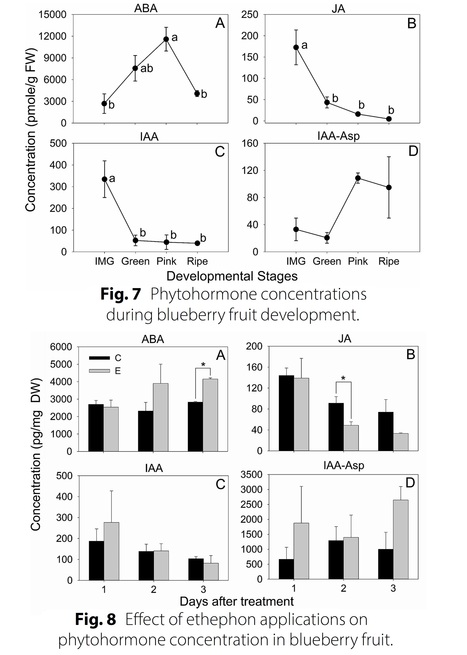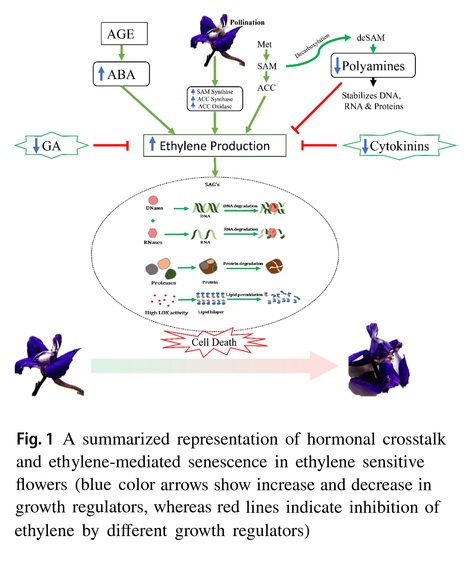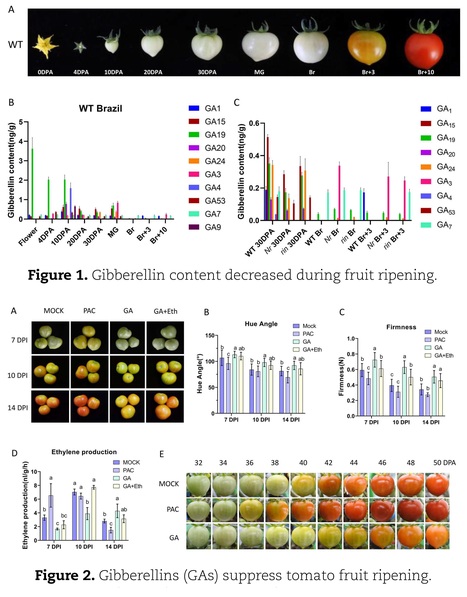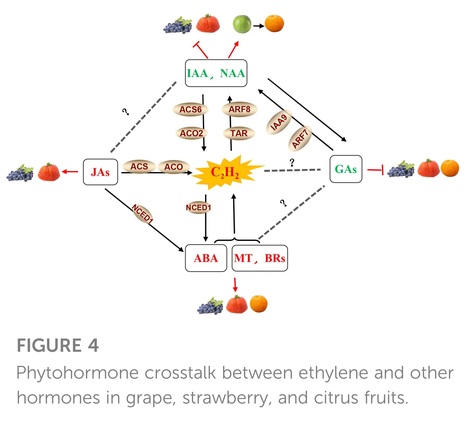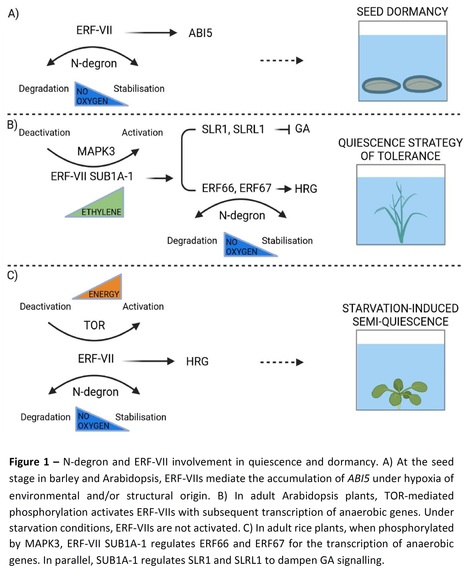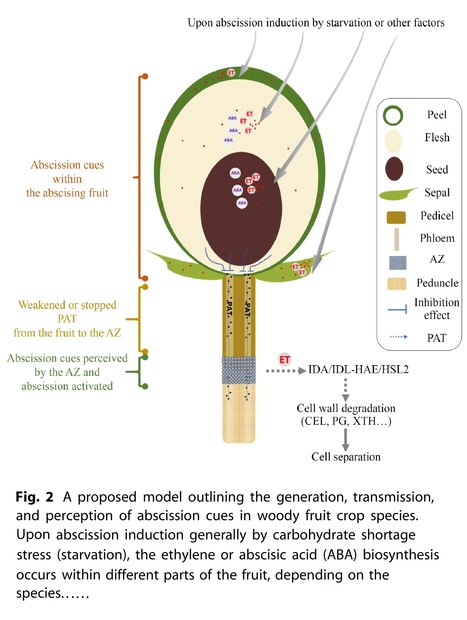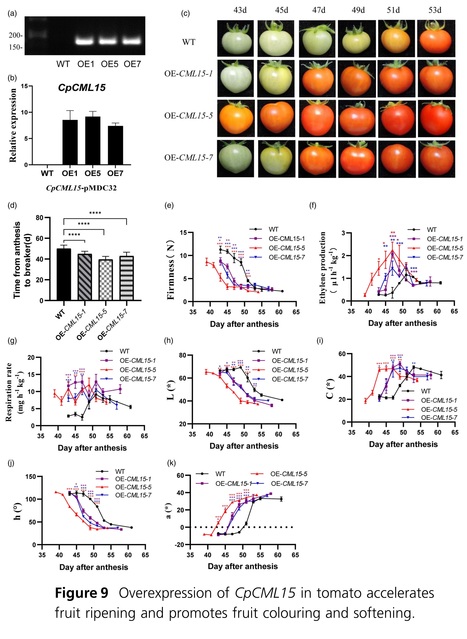 Your new post is loading...
 Your new post is loading...
Authors: Xueyuan Han, Chi Shen, Fangfang He, Yuxin Liu and Zisheng Luo.
Postharvest Biology and Technology (2024)
Highlights: • Both ethylene (ET) and ABA promoted the aroma recovery of cold-stored kiwifruit. • The pathways related to aroma synthesis were influenced by ABA or ET treatment. • ABA and ET may have different regulatory tendencies in kiwifruit aroma recovery.
Abstract: "Cold storage (CS) combined with preservative treatment is widely employed to effectively extend the storage duration of kiwifruit. Nevertheless, the olfactory quality of cold-stored kiwifruit tends to deteriorate during the post-ripening phase. In this study, abscisic acid (ABA) or ethylene (ET) was supplementary administered to cold-stored kiwifruit (CS combined with a preservative 1-MCP treatment) prior to transferring from CS, with the aim of examining the impact of ABA and ET on aroma restitution during the post-ripening period (designated as MCP+ABA and MCP+ET, respectively). The results revealed that the firmness of the MCP+ABA and MCP+ET treatments remained higher than that of the control (CK, without 1-MCP treatment) throughout the post-ripening phase, both of which moreover promoted the accumulation of soluble solids and titratable acids in kiwifruit comparing to 1-MCP group. The ethylene production and respiration rate of the fruit treated with MCP+ET and MCP+ABA fell within the intermediate range between the 1-MCP and CK groups. Compared to the 1-MCP group, both MCP+ABA and MCP+ET treatments significantly improved the accumulation of volatile components, particularly aldehydes and ketones during the early stage, and esters during the later stage of post-ripening. The activity analysis of pivotal enzymes involved in aroma biosynthesis revealed that ABA stimulated an increase in alcohol dehydrogenase (ADH) activity, while ET had a notable inducing effect on alcohol acyltransferase (AAT) and hydroperoxide lyase (HPL) activities. Furthermore, transcriptomic sequencing analysis revealed differential induction of gene expression in the pathways associated with aroma biosynthesis by ABA and ET, wherein they significantly upregulated distinct genes. Additionally, principal component analysis provided a more intuitive depiction that ABA and ET appeared to enhance the restoration of aroma in cold-stored kiwifruit by activating diverse metabolic pathways or key genes. In a comprehensive assessment, the present study postulates that both ABA and ET exert restorative effects on the aroma of cold-stored kiwifruit, thus offering theoretical support for aroma restitution technology in cold-stored fruit."
Authors: Pierre Gautrat, Sanne E. A. Matton, Lisa Oskam, Siddhant S. Shetty, Kyra J. van der Velde and Ronald Pierik.
Journal of Experimental Botany (2024)
Abstract: "Plants growing in dense vegetation stands need to flexibly position their photosynthetic organs to ensure optimal light capture in a competitive environment. They do so through a suite of developmental responses referred to as the shade avoidance syndrome. Belowground, root development is also adjusted in response to aboveground neighbour proximity. Canopies are dynamic and complex environments with heterogeneous light cues in the far-red, red, blue and UV spectrum, which can be perceived with photoreceptors by spatially separated plant tissues. Molecular regulation of plant architecture adjustment via PHYTOCHROME-INTERACTING FACTOR (PIF) transcription factors and growth-related hormones such as auxin, gibberellic acid, brassinosteroids and abscisic acid were historically studied without much attention to spatial or tissue-specific context. Recent developments and technologies have, however, sparked strong interest in spatially explicit understanding of shade avoidance regulation. Other environmental factors such as temperature and nutrient availability interact with the molecular shade avoidance regulation network, often depending on the spatial location of the signals, and the responding organs. Here, we aim to review recent advances in how plants respond to heterogenous light cues and integrate these with other environmental signals."
Authors: Yi-Wen Wang and Savithri U. Nambeesan.
BMC Plant Biology (2024)
Abstract: "Background - Blueberry fruit exhibit atypical climacteric ripening with a non-auto-catalytic increase in ethylene coincident with initiation of ripening. Further, application of ethephon, an ethylene-releasing plant growth regulator, accelerates ripening by increasing the proportion of ripe (blue) fruit as compared to the control treatment. To investigate the mechanistic role of ethylene in regulating blueberry ripening, we performed transcriptome analysis on fruit treated with ethephon, an ethylene-releasing plant growth regulator. Results - RNA-Sequencing was performed on two sets of rabbiteye blueberry (‘Powderblue’) fruit: (1) fruit from divergent developmental stages; and (2) fruit treated with ethephon, an ethylene-releasing compound. Differentially expressed genes (DEGs) from divergent developmental stages clustered into nine groups, among which cluster 1 displayed reduction in expression during ripening initiation and was enriched with photosynthesis related genes, while cluster 7 displayed increased expression during ripening and was enriched with aromatic-amino acid family catabolism genes, suggesting stimulation of anthocyanin biosynthesis. More DEGs were apparent at 1 day after ethephon treatment suggesting its early influence during ripening initiation. Overall, a higher number of genes were downregulated in response to ethylene. Many of these overlapped with cluster 1 genes, indicating that ethylene-mediated downregulation of photosynthesis is an important developmental event during the ripening transition. Analyses of DEGs in response to ethylene also indicated interplay among phytohormones. Ethylene positively regulated abscisic acid (ABA), negatively regulated jasmonates (JAs), and influenced auxin (IAA) metabolism and signaling genes. Phytohormone quantification supported these effects of ethylene, indicating coordination of blueberry fruit ripening by ethylene. Conclusion - This study provides insights into the role of ethylene in blueberry fruit ripening. Ethylene initiates blueberry ripening by downregulating photosynthesis-related genes. Also, ethylene regulates phytohormone-metabolism and signaling related genes, increases ABA, and decreases JA concentrations. Together, these results indicate that interplay among multiple phytohormones regulates the progression of ripening, and that ethylene is an important coordinator of such interactions during blueberry fruit ripening.
Authors: Sahana Basu, Monika, Surbhi Kumari and Gautam Kumar.
Plant Physiology and Biochemistry (2024)
Highlights: • IAA induces lateral root formation in rice under submergence • ROS and RNS cause lysigenous aerenchyma formation in root cortex of rice • Submergence decreases ABA level, causing GA-mediated escape response in rice shoot • Enhanced antioxidant levels dampen nitro-oxidative damage during de-submergence
Abstract: "Constant change in global climate has become the most important limiting factor to crop productivity. Asymmetrical precipitations are causing recurrent flood events around the world. Submergence is one of the most detrimental abiotic stresses for sustainable rice production in the rainfed ecosystems of Southeast Asia. Therefore, the development of submergence-tolerant rice is an essential requirement to encounter food security. Submergence tolerance in rice is governed by the major quantitative trait locus (QTL) designated as Submergence1 (Sub1) near the centromere of chromosome 9. The introduction of the Sub1 in high-yielding rice varieties producing near-isogenic lines (NILs) has shown extreme submergence tolerance. The present study aimed to understand the responses of rice genotype IR64 and its Sub1 NIL IR64 Sub1 following one week of complete submergence treatment. Submergence imposed severe nitro-oxidative stress in both the rice genotypes, consequently disrupting the cellular redox homeostasis. In this study, IR64 exhibited higher NADPH oxidase activity accompanied by increased reactive oxygen species, reactive nitrogen species, and malondialdehyde buildups and cell death under submergence. Higher accumulations of 1-Aminocyclopropane-1-carboxylic acid, gibberellic acid, and Indole-3-acetic acid were also observed in IR64 which accelerated the plant growth and root cortical aerenchyma development following submergence. In contrast, IR64 Sub1 had enhanced submergence tolerance associated with an improved antioxidant defense system with sustainable morpho-physiological activities and restricted root aerenchyma formation. The comprehensive analyses of the responses of rice genotypes with contrasting submergence tolerance may demonstrate the intricacies of rice under complete submergence and may potentially contribute to improving stress resilience by advancing our understanding of the mechanisms of submergence tolerance in rice."
Authors: Xiaofang Li, Xin Zheng, Nikita Yadav, Shouvik Saha, El-Sayed Salama, Xiangkai Li, Likun Wang and Byong-Hun Jeon.
Plant Communications (2024)
Abstract: The Green Revolution of the mid-20th century transformed agriculture worldwide and has resulted in environmental challenges. A new approach, the Second Green Revolution, seeks to enhance agricultural productivity while minimizing negative environmental impacts. Plant microbiomes play critical roles in plant growth and stress responses, and understanding plant–microbiome interactions is essential for developing sustainable agricultural practices that meet food security and safety challenges, which are among the United Nations Sustainable Development Goals. This review provides a comprehensive exploration of key deterministic processes crucial for developing microbiome management strategies, including the host effect, the facilitator effect, and microbe–microbe interactions. A hierarchical framework for plant microbiome modulation is proposed to bridge the gap between basic research and agricultural applications. This framework emphasizes three levels of modulation: single-strain, synthetic community, and in situ microbiome modulation. Overall, rational management of plant microbiomes has wide-ranging applications in agriculture and can potentially be a core technology for the Second Green Revolution."
Authors: Kangning Zhang, Hongli Xie, Jiangqi Wen, Jing Zhang, Zeng-Yu Wang, Bin Xu and Maofeng Chai.
Grass Research (2024)
Abstract: "Leaf senescence is a complex biological process regulated by development, phytohormones, and various environmental factors. For forage and turf grasses, controlling leaf senescence can greatly improve forage quality, the amenity of lawn and turf, and the grasses’ stress tolerances. Leaf senescence involves a multitude of gene regulation and metabolic changes, including the alteration of chlorophyll metabolism. Here, we summarized the recent progress of studies on leaf senescence in major forage and turf grass species, such as Medicago truncatula, M. sativa, Lolium perenne, Panicum virgatum, and Agrostis stolonifera, to provide an insight into the development of effective methods for delaying leaf senescence in grass species."
Authors: Foziya Altaf, Shazia Parveen, Sumira Farooq, Mohammad Lateef Lone, Aehsan Ul Haq and Inayatullah Tahir
Theoretical and Experimental Plant Physiology (2024)
Abstract: "Due to the already strained and severely challenged agricultural ecosystems of the modern world, predicted changes in life cycle of plants, including leaf senescence are receiving significant attention from stakeholders. The onset, progression and terminal phases of leaf senescence are greatly influenced by plant hormones. The senescence of leaves is accelerated by ethylene, jasmonic acid (JA), salicylic acid (SA), abscisic acid (ABA), brassinosteroids and strigolactones (SLs), whereas it is postponed by cytokinins (CKs), gibberellic acid (GA) and auxins. The crosstalk and signal transduction pathways between these growth regulators have been found to regulate leaf senescence by orchestrating various developmental and environmental factors. Premature leaf senescence lessens the plant’s nutritional capacity and shortens the vegetative production schedule, prompting an early transition from the vegetative to the reproductive stage and diminishing crop potential. As a result, a complete understanding of leaf senescence and finding novel ways to delay it is crucial for agricultural productivity. The ability to manipulate leaf senescence for agricultural enhancement has been made possible by significant advances in physiological and molecular awareness of leaf senescence. Although studies pertaining to leaf senescence have been given steadily more attention, there are still numerous challenges that need to be resolved. In this perspective, this review focuses on current advances in understanding the leaf senescence by molecular and genetic analyses with an emphasis on hormonal regulation of leaf senescence. We also hypothesize future research to better comprehend leaf senescence by employing various current technologies."
Authors: Aehsan ul Haq, Sumira Farooq, Mohammad Lateef Lone, Shazia Parveen, Foziya Altaf and Inayatullah Tahir
Journal of Plant Growth Regulation (2024)
Abstract: "Postharvest senescence of cut flowers is a stumbling impediment in harnessing their commercial potential. Consequently, the postharvest quality preservation of cut flowers is a crucial factor to allure buyers and maximize economic gains. Flower senescence being final phase of organ development is a key factor triggering postharvest quality deterioration. The process of flower senescence is closely regulated by developmental and environmental cues. The perception of these signals subsequently involves loss of membrane integrity, decreased activity of antioxidant enzymes, and upregulation of proteases and nucleases, which are key signatures of senescence and culminate in the death of petal tissues. Moreover, the developmental and environmental cues are synchronized by considerable turnover in different growth regulators, particularly cytokinins, abscisic acid, ethylene, and gibberellic acid, which act both antagonistically and synergistically to coordinate the senescence process in flowers. Among these growth regulators, ethylene has a crucial role in orchestrating petal senescence in ethylene-responsive systems, while, abscisic acid regulates petal senescence in ethylene-independent systems. Recent research on ethylene-sensitive flowers revealed that the crosstalk of ethylene with sugars and other growth regulators plays a crucial role in modulating senescence by affecting the expression of ethylene-responsive genes. Despite the plethora of postharvest studies conducted so far, considerable miss links still persist in understanding the intricacies of senescence regulating mechanisms, mainly in ethylene-responsive flowers. To this end, it is imperative to critically re-evaluate our current understanding of ethylene-dependent flower senescence to gain intricate inputs regarding the underlying senescence mechanisms, particularly in ornamental families like Ranunculaceae. This constitutes the pivotal gateway toward deciphering the enigmatic complexities governing senescence regulatory mechanisms, thereby forging a path for postharvest researchers to craft pioneering methodologies aimed at accentuating the longevity of commercially significant flowers, thereby yielding substantial economic ramifications."
Authors: Mengbo Wu, Kaidong Liu, Honghai Li, Ying Li, Yunqi Zhu, Dan Su, Yaoxin Zhang, Heng Deng, Yikui Wang and Mingchun Liu.
Horticulture Research (2024)
Abstract: "The phytohormone ethylene is well known for its important role in the ripening of climacteric fruit, such as tomato (Solanum lycopersicum). However, the role and mode of action of other plant hormones in climacteric fruit ripening regulation are not fully understood. Here, we showed that exogenous GA treatment or increasing endogenous gibberellin content by overexpressing the gibberellin synthesis gene SlGA3ox2 specifically in fruit tissues delayed tomato fruit ripening, whereas treatment with the GA biosynthesis inhibitor paclobutrazol (PAC) accelerated fruit ripening. Moreover, exogenous ethylene treatment cannot completely reverse the delayed fruit ripening phenotype. Furthermore, exogenous GA treatment of ethylene signalling mutant Never ripe (Nr) or SlEBF3-overexpressing lines still delayed fruit ripening, suggesting that GA involved in fruit ripening partially depends on ethylene. Transcriptome profiling showed that gibberellin affect the ripening of fruits by modulating the metabolism and signal transduction of multiple plant hormones, such as auxin and abscisic acid, in addition to ethylene. Overall, the results of this study provide new insight into the regulation of gibberellin in fruit ripening through mediating multiple hormone signals."
Authors: Wei Wu, Shi-feng Cao, Li-yu Shi, Wei Chen, Xue-ren Yin, Zhen-feng Yang.
Frontiers in Pant Science (2023)
Abstract: "Fruits are highly recommended nowadays in human diets because they are rich in vitamins, minerals, fibers and other necessary nutrients. The final stage of fruit production, known as ripening, plays a crucial role in determining the fruit’s quality and commercial value. This is a complex physiological process, which involves many phytohormones and regulatory factors. Among the phytohormones involved in fruit ripening, abscisic acid (ABA) holds significant importance. ABA levels generally increase during the ripening process in most fruits, and applying ABA externally can enhance fruit flavor, hasten softening, and promote color development through complex signal regulation. Therefore, gaining a deeper understanding of ABA’s mechanisms in fruit ripening is valuable for regulating various fruit characteristics, making them more suitable for consumption or storage. This, in turn, can generate greater economic benefits and reduce postharvest losses. This article provides an overview of the relationship between ABA and fruit ripening. It summarizes the effects of ABA on ripening related traits, covering the biochemical aspects and the underlying molecular mechanisms. Additionally, the article discusses the interactions of ABA with other phytohormones during fruit ripening, especially ethylene, and provides perspectives for future exploration in this field."
Authors: B. Geldhof, O. Novák and B. Van de Poel.
Journal of Experimental Botany (2024)
Abstract: "Waterlogging leads to hypoxic conditions in the root zone that subsequently cause systemic adaptive responses in the shoot, including leaf epinasty. Waterlogging-induced epinasty in tomato has long been ascribed to the coordinated action of ethylene and auxins. However, other hormonal signals have largely been neglected, despite evidence of their importance in leaf posture control. To cover a large group of growth regulators, we performed a tissue-specific and time-dependent hormonomics analysis. This revealed that multiple hormones are differentially affected throughout a 48 h waterlogging treatment, and that leaf age determines hormone homeostasis and gates their changes during waterlogging. In addition, we distinguished early hormonal signals that contribute to fast responses towards oxygen deprivation from those that potentially sustain the waterlogging response. We found that abscisic acid (ABA) levels peak in petioles within the first 12 h of the treatment, while its precursors only rise much later, suggesting ABA transport is altered. At the same time, cytokinins (CK) and their derivatives drastically decline during waterlogging in leaves of all ages. This drop in CK possibly releases the inhibition of ethylene and auxin mediated cell elongation to establish epinastic bending. Auxins themselves rise substantially in the petiole of mature leaves, but mostly after 48 h of root hypoxia. Based on our hormone profiling, we propose that ethylene and ABA might act synergistically as an early signal to induce epinasty, while the balance of IAA and CK in the petiole ultimately regulates differential growth."
Authors: Shiyi Xie, Hongbing Luo, Wei Huang, Weiwei Jin and Zhaobin Dong.
International Journal of Plant Biology (2024)
Abstract: "Maize (Zea mays) cultivation is strongly affected by both abiotic and biotic stress, leading to reduced growth and productivity. It has recently become clear that regulators of plant stress responses, including the phytohormones abscisic acid (ABA), ethylene (ET), and jasmonic acid (JA), together with reactive oxygen species (ROS), shape plant growth and development. Beyond their well-established functions in stress responses, these molecules play crucial roles in balancing growth and defense, which must be finely tuned to achieve high yields in crops while maintaining some level of defense. In this review, we provide an in-depth analysis of recent research on the developmental functions of stress regulators, focusing specifically on maize. By unraveling the contributions of these regulators to maize development, we present new avenues for enhancing maize cultivation and growth while highlighting the potential risks associated with manipulating stress regulators to enhance grain yields in the face of environmental challenges."
Authors: Yiliang Chen, Bo He, Mengxu Hu, Jiawei Bao, Wei Yan, Xinya Han and Yonghao Ye.
Advanced Agrochem (2024)
Highlights: • Various types of fluorescent probes for detecting phytohormones (abscisic acid, ethylene, salicylic acid, strigolactones, jasmonic acid, auxins, and cytokinin) are reviewed. • The recognition mechanisms, sensing properties and imaging quality of fluorescent probes for phytohormones are described in detail. • The prospects of fluorescent probes for sensing phytohormones are presented, and the possible improvement directions in the future are discussed.
Abstract: "Exploring plant behavior at the cellular scale in a minimally invasive manner is critical to understanding plant adaptation to the environment. Phytohormones play vital regulatory roles in multiple aspects of plant growth and development and acclimation to environmental changes. Since the biosynthesis, modification, transportation, and degradation of plant hormones in plants change with time and space, their content level and distribution are highly dynamic. To monitor the production, transport, perception, and distribution of phytohormones within undamaged tissues, we require qualitative and quantitative tools endowed with remarkably high temporal and spatial resolution. Fluorescent probes are regarded as excellent tools for widespread plant imaging because of their high sensitivity and selectivity, reproducibility, real-time in situ detection, and uncomplicated mechanism elucidation. In this review, we provide a systematical overview of the progress in the sensing and imaging of phytohormone fluorescent probes and fluorescently labeled phytohormones to their receptors in plants. Moreover, forthcoming viewpoints and possible applications of these fluorescent probes within the realm of plants are also presented. We hold the conviction that the new perspective brought by this paper can promote the development of fluorescent probes, enabling them to have better detection performance in plant hormone imaging."
|
Authors: Qingjun Xie, Danni Wang, Yuting Ding, Wenshuo Gao, Jinghang Li, Chuanwang Cao, Lili Sun, Zhongyuan Liu and Caiqiu Gao.
Science of the Total Environment (2024)
Highlights: • Various plant hormones play roles in the accumulation of Cd in T. hispida. • ABA and ethylene antagonistic regulation of Cd accumulation in T. hispida • ThDRE1A regulates Cd accumulation by regulating ThABAH2.5 and ThACCO3.1.
Abstract: "Tamarix hispida is highly tolerant to salt, drought and heavy metal stress and is a potential material for the remediation of cadmium (Cd)-contaminated soil under harsh conditions. In this study, T. hispida growth and chlorophyll content decreased, whereas flavonoid and carotenoid contents increased under long-term Cd stress (25 d). The aboveground components of T. hispida were collected for RNA-seq to investigate the mechanism of Cd accumulation. GO and KEGG enrichment analyses revealed that the differentially expressed genes (DEGs) were significantly enriched in plant hormone-related pathways. Exogenous hormone treatment and determination of Cd2+ levels showed that ethylene (ETH) and abscisic acid (ABA) antagonists regulate Cd accumulation in T. hispida. Twenty-five transcription factors were identified as upstream regulators of hormone-related pathways. ThDRE1A, which was previously identified as an important regulatory factor, was selected for further analysis. The results indicated that ThABAH2.5 and ThACCO3.1 were direct target genes of ThDRE1A. The determination of Cd2+, ABA, and ETH levels indicated that ThDRE1A plays an important role in Cd accumulation through the antagonistic regulation of ABA and ethylene. In conclusion, these results reveal the molecular mechanism underlying Cd accumulation in plants and identify candidate genes for further research."
Authors: Meiying Liu, Chaoran Wang, Hongliang Ji, Maoxiang Sun, Tongyu Liu, Jiahao Wang, Hui Cao and Qinggang Zhu.
Frontiers in Plant Science (2024)
Abstract: "In recent years, the ethylene-mediated ripening and softening of non-climacteric fruits have been widely mentioned. In this paper, recent research into the ethylene-mediated ripening and softening of non-climacteric fruits is summarized, including the involvement of ethylene biosynthesis and signal transduction. In addition, detailed studies on how ethylene interacts with other hormones to regulate the ripening and softening of non-climacteric fruits are also reviewed. These findings reveal that many regulators of ethylene biosynthesis and signal transduction are linked with the ripening and softening of non-climacteric fruits. Meanwhile, the perspectives of future research on the regulation of ethylene in non-climacteric fruit are also proposed. The overview of the progress of ethylene on the ripening and softening of non-climacteric fruit will aid in the identification and characterization of key genes associated with ethylene perception and signal transduction during non-climacteric fruit ripening and softening."
Authors: Vojtěch Schmidt, Roman Skokan, Thomas Depaepe, Katarina Kurtović, Samuel Haluška, Stanislav Vosolsobě, Roberta Vaculíková, Anthony Pil, Petre Ivanov Dobrev, Václav Motyka, Dominique Van Der Straeten and Jan Petrášek.
Nature Communications (2024)
Editor's view: Here, the authors show that the biosynthesis of many compounds in green algae preceded their recruitment in phytohormone signaling and metabolism in land plants.
Abstract: "The genomes of charophyte green algae, close relatives of land plants, typically do not show signs of developmental regulation by phytohormones. However, scattered reports of endogenous phytohormone production in these organisms exist. We performed a comprehensive analysis of multiple phytohormones in Viridiplantae, focusing mainly on charophytes. We show that auxin, salicylic acid, ethylene and tRNA-derived cytokinins including cis-zeatin are found ubiquitously in Viridiplantae. By contrast, land plants but not green algae contain the trans-zeatin type cytokinins as well as auxin and cytokinin conjugates. Charophytes occasionally produce jasmonates and abscisic acid, whereas the latter is detected consistently in land plants. Several phytohormones are excreted into the culture medium, including auxin by charophytes and cytokinins and salicylic acid by Viridiplantae in general. We note that the conservation of phytohormone biosynthesis and signaling pathways known from angiosperms does not match the capacity for phytohormone biosynthesis in Viridiplantae. Our phylogenetically guided analysis of established algal cultures provides an important insight into phytohormone biosynthesis and metabolism across Streptophyta. Genomic evidence dates the origins of most phytohormones to terrestrialization or later."
Authors: Chiara Pucciariello and Pierdomenico Perata.
Journal of Experimental Botany (2024)
Abstract: "Plant quiescence and seed dormancy can be triggered by reduced oxygen availability. Under water, oxygen depletion caused by flooding can culminate in a quiescent state, which is a plant strategy for energy preservation and survival. In adult plants, a quiescent state can be activated by sugar starvation, culminating in metabolic depression. In seeds, secondary dormancy can be activated by reduced oxygen availability, which creates an unfavourable state for germination. The physical dormancy of some seeds and buds includes barriers to external conditions, which indirectly results in hypoxia. The molecular processes that support seed dormancy and plant survival through quiescence under hypoxia include the N-degron pathway, which enables the modulation of ethylene responsive factors of group VII and downstream targets. This oxygen- and nitric oxide-dependent mechanism interacts with phytohormone-related pathways to control growth."
Authors: Minglei Zhao, Chun-Lin Shi and Jianguo Li.
Fruit Research (2024)
Abstract: "From an evolutionary perspective, fruit abscission is an intelligent regulatory mechanism by which fruit trees adapt to their environment and ensure offspring. However, from an agricultural production standpoint, unwanted fruit abscission can cause significant loss in fruit yield and economic value. Therefore, investigating the mechanisms of fruit abscission has always been an important focus in the field of plant research. Acquiring a thorough comprehension of the underlying mechanisms responsible for fruit abscission is highly valuable for enhancing fruit crop breeding and optimizing harvesting practices. In this review, we focus on fruit abscission, particularly discussing the nature of abscission cues within the abscising fruit, how these signals are generated and transmitted, and how the abscission zone cells perceive and respond to these signals in woody fruit crops."
Authors: Jana Jarošová, Sylva Prerostova, Martin Černý, Petre Dobrev, Alena Gaudinova, Vojtech Knirsch, Eva Kobzová, Karel Müller, Roman Fiala, Kinga Benzcúr, Gabriella Szalai, Jan Novák, Břetislav Brzobohatý, Ondrej Novak and Radomira Vankova.
Environmental and Experimental Botany (2024)
Highlights: • Targeted stresses affected proteins predominantly in the non-exposed organs • Abscisic acid in roots after all cold treatments regulated hydraulic conductivity • Jasmonates in stressed leaves might diminish stress effects on photosynthesis • Salicylic acid probably enhanced sugar unloading from phloem in roots under stress • Pre-acclimation enhanced stress tolerance, and speeded up recovery
Abstract: "Rice is a plant species sensitive to cold stress, which renders seriously its cultivation. Responses to cold stress (5°C, 24 hours) in whole plants, or targeted to rice leaves or roots were followed at the hormonome, transcriptome, proteome, and sugar levels, to find organ-specific responses and processes affected by cold acclimation. Targeted stresses caused proteomic changes mainly in the unexposed organs. An increase in abscisic acid (ABA) was accompanied by a decrease in jasmonic acid (JA) (in roots and non-stressed leaves) and vice versa (JA increased in stressed leaves). Both hormones promote the cold tolerance of plants. In this way, JA could indirectly reduce negative effects of cold on photosynthesis in leaves, while ABA dominates in roots (stimulation of protective substances, especially dehydrins, control of water regime). The decrease in cytokinins trans-zeatin and dihydrozeatin in crowns correlated with stress-induced growth suppression. Leaf-targeted cold stress impaired photosynthesis and decreased sugar levels, diminishing their transport, which correlated with an increase in salicylic acid, which is a signal for sugar unloading from phloem into roots. Root-targeted stress suppressed cytokinin biosynthesis and upward transport, and promoted sugar accumulation in leaves. Acclimation per se activated the transcriptome and proteome response to cold –ABA, JA and ethylene were upregulated, moderately suppressing plant growth. Pre-acclimated plants showed less profound hormonal changes than directly stressed plants, positively affecting levels of growth-related phytohormones in the unexposed organs (cytokinins in roots of leaf-stressed plants; auxins in leaves of root-stressed plants)."
Authors: Júlia de Paiva Gonçalves, Karla Gasparini, Edgard T. Picoli, Maximiller Dal-Bianco Costa, Wagner L. Araujo, Agustin Zsögön and Dimas M. Ribeiro.
Journal of Plant Physiology (2024)
Abstract: "Seed development, dormancy, and germination are connected with changes in metabolite levels. Not surprisingly, a complex regulatory network modulates biosynthesis and accumulation of storage products. Seed development has been studied profusely in Arabidopsis thaliana and has provided valuable insights into the genetic control of embryo development. However, not every inference applies to crop legumes, as these have been domesticated and selected for high seed yield and specific metabolic profiles and fluxes. Given its enormous economic relevance, considerable work has contributed to shed light on the mechanisms that control legume seed growth and germination. Here, we summarize recent progress in the understanding of regulatory networks that coordinate seed metabolism and development in legumes."
Authors: Md Mahadi Hasan, Xu-Dong Liu, Guang-qian Yao, Jianquan Liu and Xiang-Wen Fang.
Journal of Experimental Botany (2024)
Abstract: "Ethylene, a plant hormone that significantly influences both plant growth and response to stress, plays a well-established role in stress signaling. However, its impact on stomatal opening and closure during dehydration and rehydration remains relatively unexplored and is still debated. Exogenous ethylene has been proven to induce stomatal closure through a series of signaling pathways, including the accumulation of reactive oxygen species (ROS), subsequent synthesis of nitric oxide (NO) and hydrogen sulfide (H2S), and SLOW ANION CHANNEL-ASSOCIATED 1 (SLAC1) activation. Thus, it has been suggested that ethylene might function to induce stomatal closure synergistically with abscisic acid (ABA). Furthermore, it has also been shown that increased ethylene can inhibit ABA- and jasmonic acid (JA)-induced stomatal closure, thus hindering drought-induced closure during dehydration. Simultaneously, other stresses, such as chilling, ozone pollution and K+ deficiency, inhibit drought and ABA-induced stomatal closure through an ethylene synthesis dependent way. However, ethylene has been shown to take on an opposing role during rehydration, preventing stomatal opening in the absence of ABA through its own signaling pathway. These findings offer novel insights into the function of ethylene in stomatal regulation during dehydration and rehydration, gaining a better understanding of the mechanisms underlying ethylene-induced stomatal movement in seed plants."
Authors: Qiunan Zhu, Qinqin Tan, Qiyang Gao, Senlin Zheng, Weixin Chen, Jean-Philippe Galaud, Xueping Li and Xiaoyang Zhu.
Plant Biotechnology Journal (2024)
Abstract: "It is well known that calcium, ethylene and abscisic acid (ABA) can regulate fruit ripening, however, their interaction in the regulation of fruit ripening has not yet been fully clarified. The present study found that the expression of the papaya calcium sensor CpCML15 was strongly linked to fruit ripening. CpCML15 could bind Ca2+ and served as a true calcium sensor. CpCML15 interacted with CpPP2C46 and CpPP2C65, the candidate components of the ABA signalling pathways. CpPP2C46/65 expression was also related to fruit ripening and regulated by ethylene. CpCML15 was located in the nucleus and CpPP2C46/65 were located in both the nucleus and membrane. The interaction between CpCML15 and CpPP2C46/65 was calcium dependent and further repressed the activity of CpPP2C46/65 in vitro. The transient overexpression of CpCML15 and CpPP2C46/65 in papaya promoted fruit ripening and gene expression related to ripening. The reduced expression of CpCML15 and CpPP2C46/65 by virus-induced gene silencing delayed fruit colouring and softening and repressed the expression of genes related to ethylene signalling and softening. Moreover, ectopic overexpression of CpCML15 in tomato fruit also promoted fruit softening and ripening by increasing ethylene production and enhancing gene expression related to ripening. Additionally, CpPP2C46 interacted with CpABI5, and CpPP2C65 interacted with CpERF003-like, two transcriptional factors in ABA and ethylene signalling pathways that are closely related to fruit ripening. Taken together, our results showed that CpCML15 and CpPP2Cs positively regulated fruit ripening, and their interaction integrated the cross-talk of calcium, ABA and ethylene signals in fruit ripening through the CpCML15-CpPP2Cs-CpABI5/CpERF003-like pathway."
Authors: Alba Arabia, Sergi Munné-Bosch and Paula Muñoz.
Postharvest Biology and Technology (2024)
Highlights: • Ascorbic acid modulates the fruit ripening onset. • Ascorbic acid controls fruit softening and color. • Ascorbic acid interacts with other key players of fruit ripening and overripening. • Ascorbic acid may prevent postharvest physiological disorders.
Abstract: "Ascorbic acid plays an essential role in human health and its deficiency severely impacts physical well-being. Fruits are a good dietary source of ascorbic acid and thereby, its composition and strategies to increase total vitamin C contents in fruits have been reviewed previously. Nevertheless, ascorbic acid is also a fundamental antioxidant that regulates fruit ripening by its efficiency to eliminate reactive oxygen species and modulate the cellular redox state. The present review summarizes current knowledge on ascorbic acid from a plant physiological perspective both during preharvest and postharvest to dissect key regulatory points and offers an updated discussion on its capacity to regulate fruit ripening. At the same time, ascorbic acid capacity to modulate ethylene and abscisic acid signaling is discussed, together with its relevance to control the cellular redox state thereby fine-tuning fruit ripening onset and postharvest shelf-life. Finally, we emphasize the relevance of ascorbic acid to regulate fruit physiological disorders during postharvest and its relationship with current technologies of postharvest management."
Authors: Agata Kućko, Juan de Dios Alché, Timothy John Tranbarger and Emilia Wilmowicz.
Journal of Plant Physiology (2023)
Highlights: • ABA and ET stimulate jasmonic acid accumulation in the flower abscission zone. • Manifestation of lipid metabolism initiation is the induction of LOX by ABA and ET. • COI1 is sensitive to hormonal stimulators of flower abscission. • ABA- and ET-mediated abscission of flowers is linked with MYC2 transcription factor. • ABA and ET act via jasmonates to promote flower abortion in lupine.
Abstract: "The appropriate timing of plant organ abscission determines plant growth, development, reproductive success, and yield in relation to crop species. Among these, yellow lupine is an example of a crop species that loses many fully developed flowers, which limits the formation of pods with high-protein seeds and affects its economic value. Lupine flower abscission, similarly to the separation of other organs, depends on a complex regulatory network functioning in the cells of the abscission zone (AZ). In the present study, genetic, biochemical, and cellular methods were used to highlight the complexity of the interactions among strong hormonal stimulators of abscission, including abscisic acid (ABA), ethylene, and jasmonates (JAs) precisely in the AZ cells, with all results supporting that the JA-related pathway has an important role in the phytohormonal cross-talk leading to flower abscission in yellow lupine. Based on obtained results, we conclude that ABA and ET have positive influence on JAs biosynthesis and signaling pathway in time-dependent manner. Both phytohormones changes lipoxygenase (LOX) gene expression, affects LOX protein abundance, and JA accumulation in AZ cells. We have also shown that the signaling pathway of JA is highly sensitive to ABA and ET, given the accumulation of COI1 receptor and MYC2 transcription factor in response to these phytohormones. The results presented provide novel information about the JAs-dependent separation of organs and provide insight and details about the phytohormone-related mechanisms of lupine flower abscission."
Authors: Yanna Xu, Congjun You, Changbin Xu, Chaofan Zhang, Xiaoli Hu, Xiaolong Li, Haijie Ma, Jinli Gong and Xuepeng Sun.
Postharvest Biology and Technology (2024)
Highlights: • Skin coloration of tomato fruit responds differentially to red and blue light. • Both lights promote biosynthesis of carotenoids and phytohormones. • Gene modules associated with carotenoid and hormone metabolism were identified. • Transcription factors as key regulators of the modules were uncovered. • A working model was proposed to depict the light regulation of fruit coloration.
Abstract: "Understanding how light regulates pigment composition and accumulation is crucial for postharvest management of fruit quality and nutritional value. In this study, we investigated the influence of light quality, specifically the blue and red lights, on coloration of tomato fruit. We show that both lights expedite the progress of skin coloration in tomato fruit by promoting chlorophyll degradation, stimulating carotenoid biosynthesis, accelerating plastid conversion, and enhancing plant hormone (i.e., abscisic acid and ethylene) biosynthesis. However, red light shows higher efficiency in inducing color transition compared with blue light. Gene expression network analysis unraveled several modules that are associated with carotenoid metabolism and hormone biosynthesis in response to light treatments, among which the transcription factors including WRKY20, MYB12, ARR11, NAC16, bHLH46, ZNF69, and MYB58 were identified as potential key regulators. Collectively, our data provide new threads on the regulation of fruit coloration by light quality and highlight the potential utility of red LED treatment to improve the color and quality of tomato fruit."
|




 Your new post is loading...
Your new post is loading...

